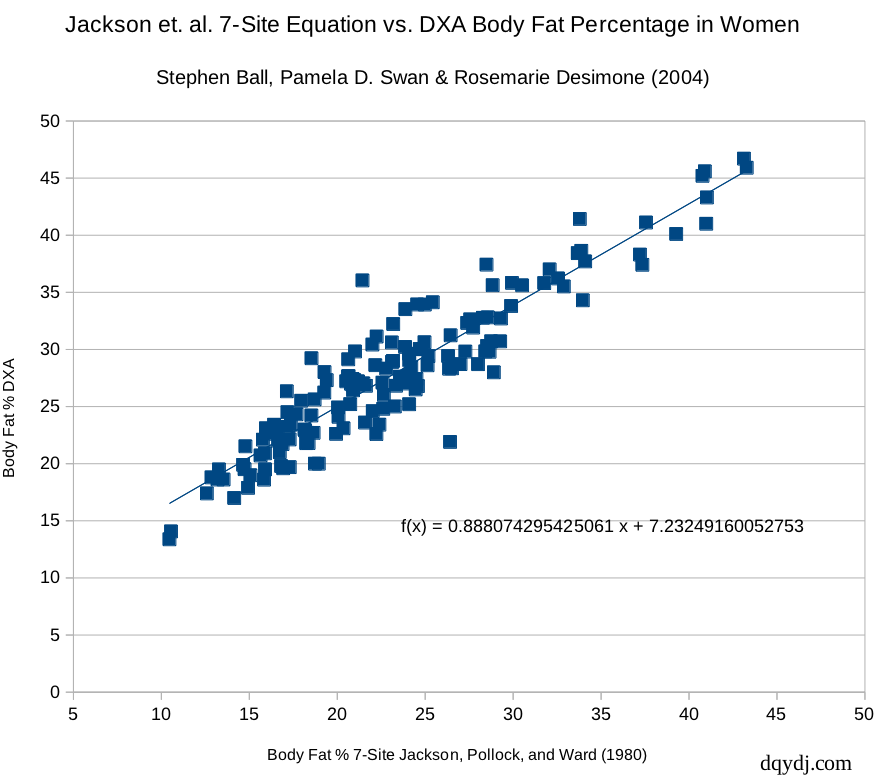On this page is a body fat distribution calculator for adult men and women in the United States in 2015-2016 and 2005-2006. It can estimate distributions for either DEXA scan body fat percentages or Caliper or Hydrostatic Weighing body fat percentage estimates.
We use the classic $15 Accu-Measure caliper to track our own body fat percentage. You can also estimate your body fat from your waist size and height.
Please see the body fat percentage comparison methodology below detailing the data derivation, and the discussion on differences in DXA and Calipers.
Body Fat Percentage Calculator for Comparing US Adults
The tool uses 2005-2006 and 2015-2016 NHANES data from the CDC to construct the body fat percentage distribution.
Using the Body Fat Comparison Calculator
- Body Fat Percentage - enter a body fat percentage to compare against the various distributions.
- Male / Female - select the sex of the person measured
- Measurement - answer whether the body fat percentage was estimated from calipers or hydrostatic weighting, or by DXA scan (Dual-energy X-ray Absorptiometry).
- "BodPod" will better track with DXA
- Bioimpedence better tracks Calipers.
- Calculate - when all fields are ready, hit the button to rank a percentile
- Compare to: - Choose the distribution to compare against. Note again, there is roughly a 4% difference between estimate types. See the methodology section for more.
The body fat percentage distribution visualization is interactive. Hover your mouse over the graph to see the male/female body fat percentage breakpoints for each centile.
Median and Average Body Fat Percentage for Men and Women
Adult men and women have different fat distributions, both pre- and post- menopause. It's estimated that men have ~2-5% essential fat – that is, without that fat they would not survive. Women have between ~9-13% essential fat.
When a bodybuilder steps on stage at a quoted "3-6%", you're probably seeing someone with little subcutaneous (below skin) fat and nearly zero extra visceral (between organs) fat.
Average and Median Body Fat Percentage for Women
In 2015-2016, women in the United States averaged 40.9% as measured by DXA. We estimate that would measure 38.0% body fat using calipers.
Women had a median body fat percentage of 41.6%. With calipers, that would be roughly 38.7%.
Average and Median Body Fat Percentage for Men
In 2015-2016, men in the United States averaged 28.7% measured by DXA. That would measure roughly 26.9% body fat using calipers.
Men had a median body fat percentage of 28.2%. With calipers, that would be roughly 26.4%.
Selected Body Fat Percentage Centiles for Men and Women
| Body Fat % | Men (DXA) | Women (DXA) | Men (Caliper) | Women (Caliper) |
| 1% | 14.3% | 24.2% | 10.6% | 19.1% |
| 10% | 19.1% | 31.5% | 16.0% | 27.3% |
| 25% | 23.9% | 36.5% | 21.5% | 32.9% |
| 50% | 28.2% | 41.6% | 26.4% | 38.7% |
| 75% | 32.4% | 45.8% | 31.1% | 43.5% |
| 90% | 36.5% | 49.1% | 35.8% | 47.2% |
| 99% | 43.0% | 54.5% | 43.2% | 53.2% |
Healthy Body Fat Percentage
Disclaimer: Nothing on this site is medical advice. If you are concerned with your body fat, please consult a medical professional.
The American Council on Exercise publishes body fat percentage ranges which roughly correspond with BMI health categories. These numbers are based on caliper or hydrostatic weighting body fat percentage readings.
ACE Health Guidelines for Body Fat Percentage Ranges (Caliper)
| Health Range | Women | Men |
| Essential Fat | 10-13% | 2-5% |
| Athletic | 14-20% | 6-13% |
| Fit | 21-24% | 14-17% |
| Acceptable | 25-31% | 18-24% |
| Obese | 32%+ | 25%+ |
ACE Health Guidelines for Body Fat Percentage Ranges (DXA Scan)
These are estimated for DXA using the equations in the methodology section below.
| Health Range | Women | Men |
| Essential Fat | 16.1-18.8% | 6.8-9.4% |
| Athletic | 19.7-25% | 10.3-16.5% |
| Fit | 25.9-28.6% | 17.4-20.0% |
| Acceptable | 29.4-34.8% | 20.9-26.1% |
| Obese | 35.7%+ | 27.0%+ |
Body Fat Percentage Distribution Methodology
Please expand the two blocks below to see our methodology. We had to estimate body fat percentage changes from the gold standard 2005-2006 data as well as convert to two-compartment models.
And before you cite this data, note that we believe it is directionally correct but not robust enough to base a study on. Carefully consider your methodology when transforming the data in the NHANES set.
2015-2016 NHANES Body Fat Percentage Estimation Methodology
The 2005-2006 NHANES set included DXA body fat percentage scans of a large number of Americans. Unfortunately, there is no corresponding DXA scan data for the 2015-2016 data set.
Orison O. Woolcott & Richard N. Bergman (2018)[1] found an accurate method to estimate DXA body fat percentage from waist circumference and standing height. We applied their Relative Fat Mass (RFM) across the curve to both 2005-2006 and 2015-2016 data.
At every centile, we took the percentage difference in the two sets and applied it to the base 2005-2006 DEXA scan data. The resulting estimate is reflected in the tool's 2015-2016 DXA dataset.
Citations
- Relative fat mass (RFM) as a new estimator of whole-body fat percentage ─ A cross-sectional study in American adult individuals Orison O. Woolcott & Richard N. Bergman (2018)
DXA and Caliper/Hydrostatic Weighting Conversions
Estimating Body Fat Percentage with Calipers
Hydrostatic Weighing and Caliper body fat estimates, such as the ones suggested by the American Council on Exercise, are based on body density estimate equations. Styles vary, but most are based (depending on sex) on Durnin, J., & Womersley, J. (1974)[1], Andrew S. Jackson & Michael L. Pollock (1978)[2], Andrew S. Jackson, Michael L. Pollock, & Ann Ward (1980)[3], or Andrew S. Jackson & Michael L. Pollock (1985)[4].
Those equations are usually based on Hydrostatic Weighing then plugged into a so-called two-compartment model, where all body mass is treated as Body Fat and Lean. The most popular two-compartment body fat percentage models, derived from post-mortem studies, are from William E. Siri (1961)[5] and Josef Brožek, Francisco Grande, Joseph T. Anderson & Ancel Keys (1963)[6].
Early models decently estimate sedentary Caucasian male and female body fat, but systematically over or underestimate body fat percentage for Black, Asian, and Hispanic males and females, as well as athletes[7][8][9][10].
Better Body Density Models

Later researchers developed 3-, 4-, 5-, (and probably more) compartment models for human density. These treat various things like fat, muscle, organ, bone, and fluid as different densities (which they are!) and vastly improve body fat percentage estimates. Spurring those efforts along were new technologies such as DXA (dual-energy X-ray absorptiometry) which easily map individuals into the compartments[11].
In short: calipers underestimate body fat as measured by more accurate measures such as DXA scans, as well as estimates based on more-than-2-compartments.
DQYDJ's Conversion Estimates
We used the 7-site regression from Stephen Ball, Thomas S Altena & Pamela D. Swan (2004)[12] to estimate the transformation between calipers/hydrostatic weighing and DXA for men. The SEE (Standard Error of the Estimate) is roughly 4.4%.

For women, we used the provided DXA to 7-Site mapping from Stephen Ball, Pamela D. Swan & Rosemarie Desimone (2004)[13] and WebPlotDigitizer to extract points. Again, assume SEE of 4.4%. (See above for regression.)
Unfortunately, DXA isn't perfect either. However, in a vacuum, DXA percentiles are a better standard than calipers (at least using older models calibrated to HW).
Citations
- Body fat assessed from total body density and its estimation from skinfold thickness: Measurements on 481 men and women aged from 16 to 72 Years. Durnin, J., & Womersley, J. (1974)
- Generalized equations for predicting body density of men. Andrew S. Jackson & Michael L. Pollock (1978)
- Generalized equations for predicting body density of women. Andrew S. Jackson, Michael L. Pollock, & Ann Ward (1980)
- Practical Assessment of Body Composition. Andrew S. Jackson & Michael L. Pollock (1985)
- Body composition from fluid spaces and density: analysis of methods William E. Siri (1961)
- Densitometric analysis of body composition: revision of some quantitative assumptions William E. Siri (1961) and Josef Brožek Francisco Grande Joseph T. Anderson & Ancel Keys (1963)
- Validity of two-component models for estimating body fat of black men Dale R. Wagner & Vivian H. Heyward (2001)
- Body fat measurement in Indian men: comparison of three methods based on a two-compartment model. Bhat DS, Yajnik CS, Sayyad MG, Raut KN, Lubree HG, Rege SS et al. (2005)
- Evaluation of Body Composition Vivian H. Heyward 1996
- Body composition measurement in highly trained male athletes: A comparison of three methods De Lorenzo, A; Bertini, I; L Iacopino E Pagliato; et al. (2000)
- Reliability and agreement between DXA-derived body volumes and their usage in 4-compartment body composition models produced from DXA and BIA values. Tinsley GM (2018)
- Comparison of anthropometry to DXA: a new prediction equation for men Stephen Ball, Thomas S Altena & Pamela D. Swan (2004)
- Comparison of Anthropometry to Dual Energy X-Ray Absorptiometry: A New Prediction Equation for Women Stephen Ball, Pamela D. Swan & Rosemarie Desimone (2004)
Body Fat Distribution for Men and Women
This was one of the harder calculators on the site to build. Not only were there no body fat percentage readings done in the 2015-2016 NHANES, but readings from DXA and calipers have systemic differences requiring conversion. Our bias towards the more recent data set led us down this overwrought path.
It's important to note, though, that if you are improving your body composition and losing fat any consistent method is great to use. Calipers, BIA scales, BodPod readings and DXA scans can all show you that you're trending in the right direction and lowering your body fat. Just be very careful when translating readings between the two - you will need to convert.
If you haven't yet, grab the cheap Accu-Measure caliper – it'll track your body fat percentage changes fine until you start competing professionally.
The key takeaway though: body fat percentage is more important as a health marker than BMI (Body Mass Index). For your reference, here is the BMI Distribution Calculator to see how you stack up in that regard.
